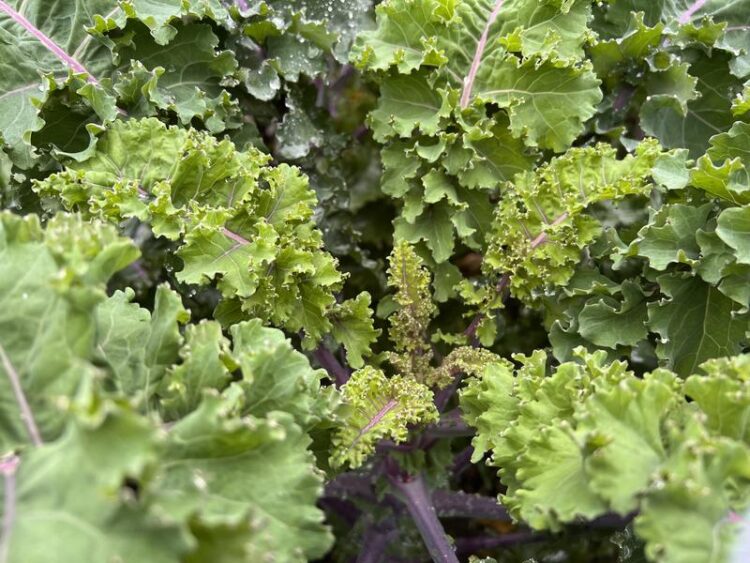The impact of cold temperatures on nutrient levels in kale depends on the variety

Kale varieties with curly leaves produce more mustard oil glycosides at low temperatures.
Photo: Universität Oldenburg / Ute Kehse
At low temperatures, the nutritional value and taste of kale change – in different ways depending on the variety. In a recently published study, a team of researchers from Oldenburg and Bremen report that the concentration of glucosinolates, which are responsible for the typical taste of kale, increases in some varieties when it gets cold, but decreases in others.
Kale is considered particularly healthy due, among other things, to its high secondary plant compound content, including the glucosinolates that give the vegetable its typical cabbage flavour. Researchers from Oldenburg and Bremen have now determined that the exact composition of these substances, also known as mustard oil glycosides, depends on environmental factors – in particular temperature – as well as genetic factors.
The research team led by Dr Christoph Hahn and Professor Dr Dirk Albach, both from the University of Oldenburg, has now published the results of their study in the science journal Horticulturae. Their findings indicate that in some kale varieties the concentration of glucosinolates increases under cold temperatures, whereas in others it decreases. “To obtain plants with an improved nutritional value, considering both temperature and the choice of cultivar is crucial,” Hahn stresses.
In an earlier study the biologist had already demonstrated that the approximately 150 kale varieties that exist worldwide can be assigned to several genetically different groups which also differ in terms of appearance, taste, colour and composition of phytochemicals. One group comprises kale varieties with curly leaves such as those typically cultivated in Northern Germany. Another group consists of Italian varieties with a milder taste and elongated, dark leaves known as “Lacinato kale”, “palm kale” or “black cabbage”. A third group is made up of varieties with broad, smooth leaves which are commonly grown in the United States and are more similar to the wild form or “feral-type” cabbage.
In the current study, Hahn’s team investigated the impact of cold temperatures on the glucosinolate composition in kale leaves. When the leaves are crushed, these substances are converted into mustard oils (isothiocyanates) which protect the vegetable from predators such as caterpillars and snails. These substances are also responsible for the vegetable’s characteristic, in some cases bitter and pungent taste. Glucosinolate levels are particularly high in feral-type kale and tend to be considerably lower in Lacinato varieties.
For their study the researchers selected the three varieties “Frostara”, “Palmizio” and “Helgoländer”, which can be assigned to the curly kale, Lacinato kale, and feral-type kale groups, respectively. They grew 45 specimens of each variety in a climate chamber at the University and exposed the adult plants to temperatures of two degrees Celsius for one week. Leaf samples for analyses of glucosinolate levels and composition were taken at warm temperatures, after twelve hours of cold exposure, and after seven days of cold exposure. Concentrations of seven different glucosinolates were analysed at all three time-points using a mass spectrometer.
The result: the scientists found that total glucosinolate levels increased at low temperatures in both the curly kale and Lacinato samples, but decreased in the feral type. This came as a surprise for the team: “Based on our previous experiments we would not have expected the Lacinato kale to react in exactly the same way as the curly variety, since it is adapted to different climatic conditions,” Hahn commented.
How these results affect the taste of kale was not investigated in the study. “For the taste not just the glucosinolates but also the sugar content is decisive,” Hahn explained. The biologist already demonstrated in a study published in 2020 that levels of sugar compounds in kale leaves also increase at low temperatures – however not only at sub-zero temperatures, as is often assumed, but already at temperatures in the above-zero single-digit range.
Wissenschaftliche Ansprechpartner:
Dr. Christoph Hahn, E-Mail: christoph.hahn@uol.de
Prof. Dr. Dirk Albach, E-Mail: dirk.albach@uol.de, Tel.: +49 (0)441 798 333
Originalpublikation:
Hahn, C.; Müller, A.; Kuhnert, N.; Albach, D.C.: “A Cold Case—Glucosinolate Levels in Kale Cultivars Are Differently Influenced by Cold Temperatures”. Horticulturae 2023, 9, 953. https://doi.org/10.3390/horticulturae9090953
Weitere Informationen:
Media Contact
All latest news from the category: Agricultural and Forestry Science
Newest articles

The surprising role of gut infection in Alzheimer’s disease
ASU- and Banner Alzheimer’s Institute-led study implicates link between a common virus and the disease, which travels from the gut to the brain and may be a target for antiviral…

Molecular gardening: New enzymes discovered for protein modification pruning
How deubiquitinases USP53 and USP54 cleave long polyubiquitin chains and how the former is linked to liver disease in children. Deubiquitinases (DUBs) are enzymes used by cells to trim protein…

Machine learning accelerates catalyst discovery
Conceptual blueprint to analyze experimental catalyst data. Machine learning (ML) models have recently become popular in the field of heterogeneous catalyst design. The inherent complexity of the interactions between catalyst…



